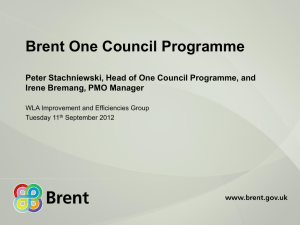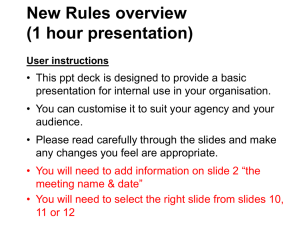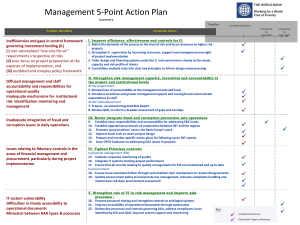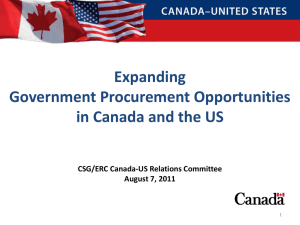the presentation. - Massachusetts Farm to School
advertisement
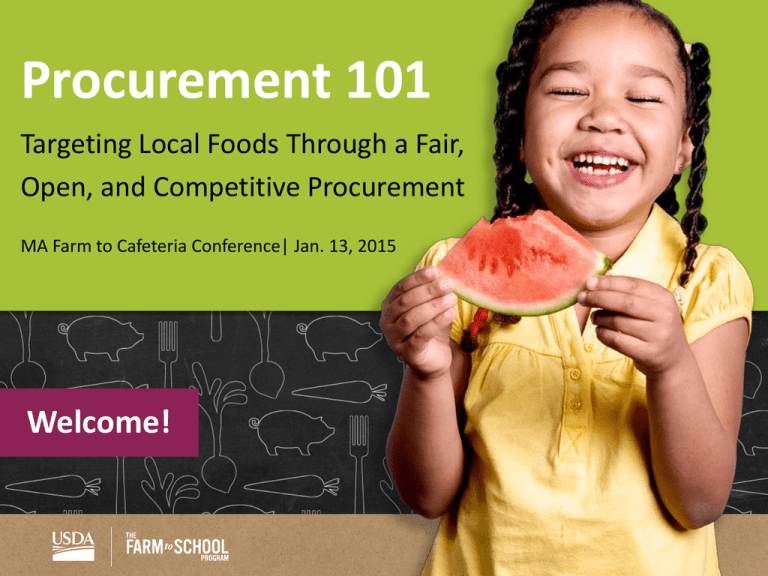
Procurement 101 Targeting Local Foods Through a Fair, Open, and Competitive Procurement MA Farm to Cafeteria Conference| Jan. 13, 2015 Welcome! Overview • Procurement principles and process • Procurement methods • Key procurement concepts • Defining local and where to find local foods • Ways to buy local products • Resources and questions What Is Procurement? Procurement is the purchasing of goods and services. The procurement process involves: Planning Drafting Specifications Advertising the Procurement Procurement Principles Awarding a Contract Managing the Contract Why are Procurement Rules Important? • To ensure that program benefits (and taxpayer dollars!): » Are received by eligible schools and children » Are used effectively and efficiently, with no waste or abuse Procurement Methods ≤ Small Purchase Threshold > Informal Small Purchase (Requires price quotes from at least 3 bidders) *NEW* Micro-Purchase Threshold of $3,000 (no bids required) Federal Threshold = $150,000 MA Threshold = $35,000 Municipality = varies Formal Sealed Bids (IFBs) & Competitive Proposals (RFPs) (Requires public advertising) NEW in 2015: Micro-purchase Threshold ≤ $3,000; Micro Purchase Threshold • [NEW] FNS Memo implementing OMB Super Circular: On February 27, 2015, FNS will issue a memorandum implementing the new Super Circular at 2 CFR Part 200. • CFR 200.320 states, “Procurement by micro-purchase is the acquisition of supplies or services, the aggregate dollar amount of which does not exceed $3,000 (or $2,000 in the case of acquisitions for construction subject to the Davis-Bacon Act). To the extent practicable, the non-Federal entity must distribute micro-purchases equitably among qualified suppliers. Micropurchases may be awarded without soliciting competitive quotations if the non-Federal entity considers the price to be reasonable.” The Informal Procurement Process The Formal Procurement Process Splitting Procurements • SFAs cannot arbitrarily divide purchases to fall below the small purchase threshold. • In some instances, however, characteristics of a product or market justify the need to separate it from the overall food procurement. …such as Harvest of the Month programs, taste tests, products for a Farm to School Month promotion. 3 Key Concepts 1) Competition 2) Knowledge of Federal, State, and Local Regulations 3) Responsive and Responsible 1 Competition Competition is essential to ensure the best cost and quality of goods and services. Why is Competition Important? • Price! » Sellers may accept a smaller margin of return on a given sale rather than make no sale at all. » Schools may receive more goods or services at a lower price than in a non-competitive environment. Why is Competition Important? • Quality! » Businesses seek to differentiate themselves in terms of quality and innovation. » Each procurement offers an opportunity to consider new and/or higher quality products and services. 2 State and Local Procurement Policies • Schools must be aware of procurement requirements at the federal, state and local levels and are responsible for complying with all levels of regulations. • In some cases, state and federal regulations may be in conflict with each other. 3 Responsive and Responsible Awards must be made to vendors that are responsive and responsible. • Responsive means that the vendor submits a bid that conforms to all terms of the solicitation. • Responsible means that the vendor is capable of performing successfully under the terms of the contract. Section Summary • Procurement is a process, not a one-time event • Informal vs. Formal Methods • Ensure competition- Price! Quality! • Follow Federal, State, and Local Procurement Policies • Make sure bidders are responsive and responsible Defining Local and Where to Find Local Foods What Does Local Mean? Who defines local? • School food authorities What are you trying to accomplish? • Is there state based initiative around local food purchasing that you would like to align with? • Do you want to couple local purchases with farm visits and have personal relationships with suppliers? • Do you want to make a definition that aligns with neighboring districts? Defining Local • Within a radius • Within a county • Within a state • Within a region A district’s definition of local may change depending on the: • Season • Product • Special events What Types of Products? What’s Already Local on Your Menu? • Look at your records. • Ask your suppliers whether they purchase local products. What Could Be Local? • Conduct a menu audit. » Are there items that could easily be replaced with local products? • Think about ways to integrate. » Harvest of the Month program » New recipe development » Salad Bar » Seasonal Cycle Menu • Include tracking of local in future contracts. Where to Get Local Foods • Through distributors • Through food service management companies • From food processors • Through DoD Fresh • From individual producers • From producer co-ops/ food hubs • From school gardens Local as a Product Specification • “X District is soliciting bids for Massachusetts-grown products.” • “This RFP is restricted to producers from within the state.” • “We are soliciting bids from producers within a 100 mile radius.” • “Only products grown within a 75 mile radius will be accepted.” What the Legislation Says Section 2403 of the 2008 Farm Bill says: “The Secretary shall allow institutions receiving funds under this Act … to use a geographic preference for the procurement of unprocessed agricultural products, both locally grown and locally raised.’’ Local as a Preference • “X District operates a Farm to School Program, and prefers to support local and regional producers.” • “We seek opportunities to incorporate local food into our program whenever possible.” • “Preference will be given to vendors that can document source of origin, and procure product from within the state.” Targeting Local through an Informal Procurement “Three Bids and a Buy” Develop a Specification • Apples, US. No. 1, five 185 count boxes per week for Sept-Dec Solicit Bids • Contact vendors (by phone, fax, email, in-person or via mail) and provide them with specifications (or if calling, read same information to each vendor). Bid Documentation • Write down each vendor’s bid and constraints; then file it. Vendor Art’s Apples Olivia’s Orchard Apple Crunch Inc. Price/box $40 $47 $37 “Three Bids and a Buy” Develop a Specification • Apples, US. No. 1, five 185 count boxes per week for Sept-Dec Solicit Bids • Contact ONLY LOCAL vendors (by phone, fax, email, in-person or via mail); provide them w specifications (or if calling, read same information to each vendor). Bid Documentation • Write down each vendor’s bid and constraints; then file it. Vendor Art’s Apples Olivia’s Orchard Apple Crunch Inc. Price/box $40 $47 $37 “Three Bids and a Buy” Develop a Specification • McIntosh or Macoun apples, US. Fancy or No. 1, prefer five 185 count boxes per week but willing to consider other pack sizes for Sept-Dec. Solicit Bids • Contact ONLY LOCAL vendors (by phone, fax, email, in-person or via mail); provide them w specifications (or if calling, read same information to each vendor). Bid Documentation • Write down each vendor’s bid and constraints; then file it. Vendor Art’s Apples Olivia’s Orchard Apple Crunch Inc. Price/box $40 $47 $37 Targeting Local Foods in a Formal Solicitation 1 Use Product Specifications to Target a Local Item Consider requesting: • A variety that is unique to the region • Product delivery within 24 or 48 hours of harvest Example: Use Product Specifications Product Specification • Granny Smith, • US. Fancy, • Five 185 count boxes per week for September - December Example: Use Product Specifications Product Specification • Granny Smith or <insert a variety grown in your target region>, • US. Fancy or No. 1, • Prefer five 185 count boxes per week but willing to consider other pack sizes for September – December • Delivered within 48 hours of harvest 2 Use Additional Requirements to Determine Vendor Responsiveness • Remember that you must award to a vendor who is both responsive and responsible! • All vendors must be able to provide the products you need to be considered responsive. Vendor requirements may include the ability to provide: » Farm visits » State, county, farm of origin labeling » Products grown on a certain size farm What can you ask for? » Particular varieties unique to the region » Freshness (e.g. Delivered within 48 hours) » Specific size of farm » Harvest techniques » Crop diversity » Origin labeling » Able to provide farm visits or class visits Other Things to Consider When Writing Solicitations to Target Local Products • Be flexible • Don’t include unnecessary requirements • Consider what a vendor new to the school food market might not know » Condition upon receipt of product » Food safety needs » Size uniformity Not sure where to start? Put out an Requests for Information (RFI) • Survey the market to understand: » Quantity available » Price point » Seasonal availability » Willingness to work with schools » Whether geographic preference is necessary » Who the producers are! • Collaborate with surrounding districts • Work with a community partner Section Summary • Defining local is up to you! • There are many sources of local foods- find which might work best for you (direct from farm, through distributor, DoD Fresh?) • Ask for what you want, but be mindful of creating a fair and open playing field for bidders (not overly restrictive) • Cite local as a preference, not a requirement NFSMI Procurement Training NFSMI Guide: Procurement in the 21st Century http://www.nfsmi.org/documentlib raryfiles/PDF/20130820034348.pdf Online training courses: Procurement Basics http://www.nfsmi.org/Templates/T emplateDefault.aspx?qs=cElEPTEzN Q Local Procurement: http://www.nfsmi.org/ResourceOver view.aspx?ID=515 More FNS Resources Local Procurement Guide and Webinar Series: http://www.fns.usda.gov/farmtos chool/procuring-local-foods Procurement of Food Service Management Companies: http://www.fns.usda.gov/sites/def ault/files/FSMCguidance-sfa.pdf Thank you! Questions? Martine Cherry martine.cherry@fns.usda.gov Danielle Fleury danielle.fleury@fns.usda.gov




